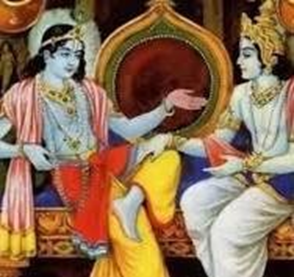(Adapted from Swami Sivananda’s book)
Fear is an emotion or vritti in the mind that is produced when one’s life or possessions are in danger on account of external forces or objects. A person reacts to the situation with a fear-emotion. Fear is an enemy of a person’s progress. It disturbs his peace and harmony. It sucks or saps his vitality and energy. It drains the nervous system of its reserve of energy. It produces physical and mental weakness. Fear is of two kinds, viz., natural, or rational fear, when there is a threatening situation to endanger life; and unnatural or unusual fear which has no objective reality.
Every person has some
imaginary fear of one kind or another. Maya will never allow anybody to rest
peacefully. The percentage of normal
fear will be only ten percent while imaginary fears will come to ninety per cent.
Imaginary fears cause diseases, deplete all energies in a person and produce all
sorts of feverish excitement, low vitality, uneasiness, discomfort, disharmony,
etc. For instance, people were subject
to general fear of covid, when there was the epidemic. Similarly, there are peculiar, private, irrational,
and unnatural fears which are called phobias, derived from the Greek word
’phobos’ meaning fear. They have no objective reality. There is nothing to
frighten people. There is no threatening situation in their environment which
should cause fear in them and yet they cannot free themselves from fears and
negative feelings, like the fear of scorpions and snakes, fear of loneliness
and darkness etc. A normal fear arises when one’s life is in danger when some
external object such as cobra or a tiger or situation like a riot threatens the
existence of the individual. The fear which arises on such occasions is
perfectly natural. A person tries to save his own life by either fight or flight.
Raga (attachment) is the
long-standing associate of fear. Wherever there is attachment, there is fear.
Fear and attachment co-exist. Man is attached to his wife and so develops fear
of losing her, fear of her death, fear of her running away with another man,
fear of her divorcing him, fear of her being displeased with him, etc. As he is also attached to his children, house,
and other possessions, he has fear of losing his children, house, property, and
other possessions. He is drowned in
sorrow and feels a shock when any of them is destroyed or lost. Hence attachment
is the cause of usual fear. The first
link in the chain of attachment is one’s attachment to one’s body, dehadhyasa.
All kinds of attachment start from this attachment
to the physical body. One must give up
attachment to this body by identifying oneself with the bodiless, sexless,
pure, all-pervading immortal Athma or Brahman. All sorts of fears
and attachments will then totally disappear. That is the reason why a
Self-realised Jnani has nothing to fear. Even for others it is possible, when
they practice dispassion towards material possessions with passion for devotion
to God. Bharthruhari states, in Vairagya-shatakam:
Bhoge rogabhayam kule
cyuthibhayam vitte nrpaladbhayam,
Maane dainyabhayam bale
ripubhayam rupe jaarayabhayam,
Sastre vadibhayam gune
khalabhayam kaye krtantadbhayam,
Sarvan vasthu bhayanvitam
bhuvi nranam vairagyamevabhayam.
“In enjoyment, there is fear of disease; in social position, there is fear of falling off; in wealth, there is the fear of (hostile) kings; in honour, there is the fear of humiliation; in power, there is the fear of foes; in beauty, there is the fear of old age; in scriptural erudition, there is the fear of opponents; in virtue, there is the fear of seducers; in body, there is the fear of death; everything in this world pertaining to a person is attended with fear; renunciation alone leads to fearlessness.”
Freedom from fear can be
achieved by liberation from the objects of fear. Re-educating the mind, dealing
with practical affairs, diligently putting into practice the knowledge that one
possesses, besides an attitude of dispassion towards the persons and
possessions are the essential factors to be cultivated to overcome fear. It
must be felt that there is no object which is to be afraid of or to be feared
and one must plant the seeds of courage in one’s heart and allow it to grow. This way one can conquer irrational fears and
rid oneself of phobias, when this attitude is supported by total devotion to
God, which enables one to realise the presence of God everywhere. This feeling of the all-pervading God being
with him supporting his efforts, transforms the sense of insecurity and fear
into one of confidence and faith and one is free of panic and despair caused by
irrational fears and gets the courage to meet the challenge of rational fears.
---------------------------------





